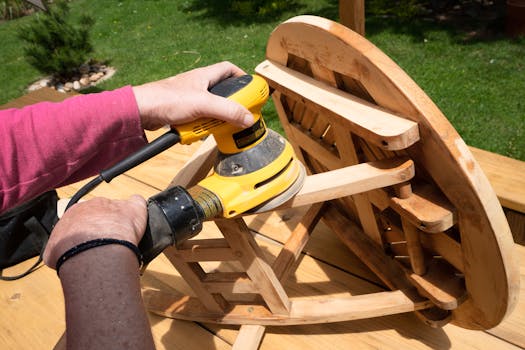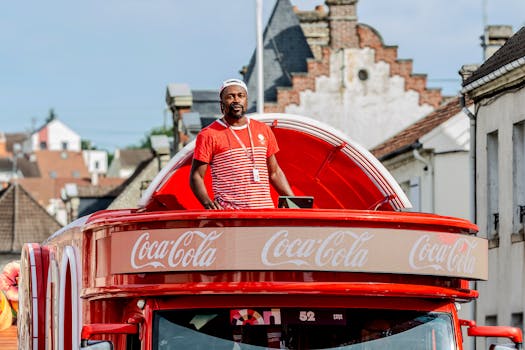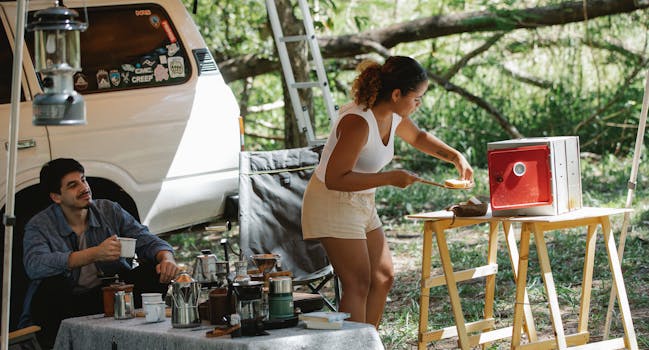Anuncios
Creación de recursos al aire libre: una guía completa
Establecer recursos al aire libre puede mejorar significativamente la vida urbana y las actividades recreativas. Estos recursos permiten a las comunidades conectar con la naturaleza a la vez que promueven estilos de vida más saludables. Además, brindan oportunidades educativas y fomentan la interacción social.
Al planificar los recursos al aire libre, es fundamental considerar las necesidades de la comunidad. Un diseño cuidadoso puede transformar terrenos infrautilizados en espacios vibrantes. Esto no solo embellece la zona, sino que también promueve la biodiversidad y la salud ambiental.
El mercado de recursos al aire libre está en crecimiento, impulsado por el creciente interés en el bienestar y la sostenibilidad. Hoy en día, las comunidades están adoptando parques, jardines, senderos y otras actividades al aire libre. La creación de estos recursos puede mejorar drásticamente la calidad de vida de los residentes.
Entendiendo las necesidades de la comunidad
Identificar las necesidades de la comunidad es el primer paso para crear recursos al aire libre exitosos. Las encuestas y las reuniones comunitarias pueden brindar información valiosa. Involucrar a la comunidad local ayuda a garantizar que los recursos se valoren y se utilicen adecuadamente.
Considere la demografía de su comunidad. Los diferentes grupos de edad y culturas tienen necesidades específicas para los espacios al aire libre. Por lo tanto, es fundamental recopilar información de diversos segmentos de la comunidad para obtener una perspectiva holística.
Anuncios
Además, concéntrese en los espacios exteriores existentes. Evaluar las instalaciones actuales puede identificar áreas que necesitan mejoras. Esto ayuda a evitar la duplicación y a reconocer lo que la comunidad ya valora.
El uso de las redes sociales puede ampliar el alcance. Las herramientas en línea permiten una rápida difusión de información y permiten involucrar a quienes no suelen asistir a reuniones públicas. Involucrar a las generaciones más jóvenes es vital para la sostenibilidad a largo plazo.
Finalmente, asegúrese de que la difusión sea inclusiva. Proporcionar materiales en varios idiomas y atender las diversas necesidades de accesibilidad puede promover una participación más amplia. Todos en la comunidad deben sentirse escuchados y valorados durante el proceso.
Anuncios
Diseño de espacios de recursos al aire libre eficaces
Una vez comprendidas las necesidades de la comunidad, el siguiente paso es un diseño eficaz. La distribución y las características deben maximizar la usabilidad y el disfrute. Colaborar con arquitectos paisajistas puede aportar una perspectiva profesional al proyecto.
La integración de diversos elementos como senderos, zonas de picnic y áreas de juegos puede satisfacer diversos intereses. Un recurso integral animará a más residentes a disfrutar del espacio. El equilibrio entre las opciones de recreación activa y pasiva es clave.
Además, la sostenibilidad debe ser la base de todas las decisiones de diseño. Las plantas nativas pueden reducir los costos de mantenimiento y, al mismo tiempo, apoyar la fauna local. Las prácticas de desarrollo de bajo impacto pueden contribuir a la preservación de los paisajes naturales y minimizar el impacto ambiental.
La seguridad es crucial en la fase de diseño. Una iluminación adecuada, líneas de visión visibles y una señalización adecuada contribuyen a un entorno acogedor. Garantizar la accesibilidad para todas las personas debe ser, sin duda, una prioridad del diseño.
Antes de finalizar los diseños, realice un proceso de revisión con la comunidad. La retroalimentación de las partes interesadas clave garantiza que el espacio cumpla con las expectativas y ajuste las características según sea necesario antes de la implementación.
Financiación y presupuesto para recursos al aire libre
Obtener financiación es un aspecto crucial del desarrollo de recursos al aire libre. Un presupuesto detallado debe detallar todos los gastos previstos, incluyendo los de construcción, mantenimiento y programación. Es fundamental identificar posibles fuentes de financiación desde el principio del proceso.
Las subvenciones gubernamentales son una vía tradicional de financiación. Numerosos programas locales, estatales y federales apoyan proyectos de recreación al aire libre. Investigue las subvenciones disponibles y elabore propuestas atractivas para su consideración.
Considere las alianzas público-privadas como otra opción de financiamiento. Colaborar con empresas locales puede generar apoyo financiero y, al mismo tiempo, mejorar la imagen de su comunidad. Esta relación mutua puede fomentar una mayor inversión en recursos públicos.
El crowdfunding también puede ser una solución viable. Utilizar plataformas como GoFundMe o Kickstarter para conseguir el apoyo de la comunidad permite recaudar fondos y, al mismo tiempo, involucrar a la población local. Comunicar claramente los beneficios del proyecto fomentará las donaciones.
Finalmente, es fundamental garantizar soluciones de financiación continua para la sostenibilidad del programa. Establecer un fondo específico para mantenimiento y futuras mejoras ayudará a mantener los recursos operativos a largo plazo. La presupuestación de estos aspectos es vital en la planificación del proyecto.
Implementando su proyecto de recursos al aire libre
Con la financiación asegurada, es hora de implementar su proyecto. Comience por desarrollar un cronograma claro que describa cada fase de la construcción. El uso de herramientas de gestión de proyectos permite mantener a todas las partes interesadas informadas y responsables.
Determine si empleará contratistas o voluntarios de la comunidad para la construcción. Involucrar a la comunidad local en el proceso de construcción puede fomentar el sentido de pertenencia y el orgullo por el proyecto finalizado. Este esfuerzo colaborativo puede fortalecer los lazos comunitarios.
Durante la construcción, mantenga la comunicación con la comunidad. Las actualizaciones periódicas ayudan a garantizar la transparencia y a mantener al público involucrado. Es probable que las personas se sientan más conectadas cuando se les informa sobre el progreso y los desafíos.
Además, es crucial abordar las inquietudes locales durante la construcción. Aspectos como el ruido o las interrupciones del tráfico deben comunicarse eficazmente para minimizar la frustración. Las buenas relaciones con los residentes fomentan la cooperación durante la fase de construcción.
Finalmente, prepárense para las inauguraciones preliminares para recopilar comentarios antes del lanzamiento oficial. Los miembros de la comunidad agradecerán la oportunidad de experimentar su nuevo recurso, lo que les brindará información valiosa para cualquier ajuste de última hora.
Mantenimiento de sus recursos al aire libre
Tras la gran inauguración, concéntrese en el mantenimiento a largo plazo de los recursos al aire libre. Establezca un plan de mantenimiento que abarque el paisajismo, las revisiones de seguridad y la reparación de los equipos. El mantenimiento regular es esencial para el uso continuo de la comunidad.
Involucrar a voluntarios en el mantenimiento del paisaje puede crear un sentido de pertenencia comunitaria. Organice eventos como los "Días de Limpieza del Parque" para fomentar la camaradería y, al mismo tiempo, mantener el área. Incentivos como refrigerios pueden fomentar la participación.
Formar alianzas con organizaciones locales también puede contribuir a las labores de mantenimiento. Por ejemplo, las escuelas pueden adoptar sitios específicos e incorporarlos a proyectos educativos. Las alianzas colaborativas propiciarán la gestión sostenible de los recursos.
Además, considere crear un fondo de mantenimiento específico. Este recurso financiero puede cubrir reparaciones o mejoras imprevistas, a la vez que garantiza que el espacio se mantenga seguro y agradable a largo plazo. Una inversión constante demuestra compromiso con la comunidad.
Por último, busque constantemente la opinión de la comunidad. Las evaluaciones periódicas ayudan a ajustar la programación, mantener la seguridad y actualizar las funciones. Recopilar información garantiza que los recursos al aire libre se adapten y prosperen según las necesidades cambiantes.
Promoción de los recursos al aire libre
Para maximizar el uso de los recursos al aire libre, es fundamental una promoción eficaz. Empiece por desarrollar una estrategia de marketing dirigida a diversos grupos demográficos de la comunidad. Utilice las redes sociales, los eventos locales y los medios de comunicación para la difusión.
Organice eventos comunitarios para llamar la atención. Organizar actividades como noches de cine al aire libre, conciertos o festivales de temporada puede dar a conocer el espacio a nuevos visitantes. Estos eventos divertidos fomentarán la participación y el disfrute de la comunidad.
Incentive a las escuelas locales a utilizar los espacios para actividades como paseos por la naturaleza o deportes. Los programas educativos pueden beneficiar a los estudiantes y fomentar la interacción comunitaria. Las escuelas pueden convertirse en firmes promotoras del uso de recursos al aire libre.
Ofrecer una programación variada también fomenta el interés continuo. Las clases regulares de jardinería, fitness o conservación de la naturaleza pueden atraer a diferentes segmentos de la población. Un horario flexible se adaptará a públicos y estilos de vida diversos.
Por último, recopile testimonios e historias de éxito. Mostrar experiencias positivas puede animar a otros a visitar el lugar. Comparta estas historias a través de boletines informativos o medios locales para fortalecer el orgullo comunitario por los recursos al aire libre.
Conclusión
La creación de recursos al aire libre transforma las comunidades al mejorar las oportunidades recreativas, promover el bienestar y fomentar las conexiones. Un enfoque meticuloso en el diseño, la financiación, la implementación y la promoción garantizará un desarrollo exitoso.
El mantenimiento continuo y la participación comunitaria son cruciales para el mantenimiento de estos valiosos espacios. En definitiva, los recursos al aire libre pueden contribuir significativamente a mejorar la calidad de vida en general. Juntos, las comunidades pueden prosperar en estos hermosos espacios al aire libre.



